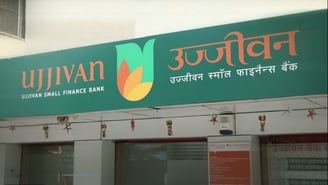Add your promotional text...
Ujjivan SFB Shares Plunge Over 7.5% Following Revised Loan Growth Forecast
Synopsis:- Shares of Ujjivan Small Finance Bank fell 7.56% to a three-week low of ₹44.70 after the bank lowered its FY25 loan growth forecast to 20% and raised its credit cost guidance to 1.7%. Increased stress in microfinance sectors across Punjab, Haryana, Gujarat, Uttar Pradesh, and Kerala prompted the bank to slow down disbursements and focus on collections. Despite these challenges, Ujjivan SFB aims to boost growth through individual loans and affordable housing, and is exploring opportunities in gold and vehicle loans. The bank meets RBI criteria for a universal banking licence, which could enhance its capital and reduce regulatory constraints.
TOP STORIES
By Vishwash Saxena
6/24/20243 min read


Shares of Ujjivan Small Finance Bank (SFB) experienced a significant drop of 7.56% during today’s intraday trading session, reaching a three-week low of ₹44.70 per share. This decline followed the bank’s announcement of a revised loan growth forecast for FY25, adjusting it to approximately 20%, down from the previous range of 20%–25%. Additionally, the bank increased its credit cost guidance to 1.7%, up from the earlier range of 1.4%–1.5%.
Factors Behind the Adjustment
The revision in forecasts is attributed to heightened stress in the microfinance sector in specific hotspot states, including Punjab, Haryana, Gujarat, Uttar Pradesh (UP), and Kerala. In response, Ujjivan SFB has decided to decelerate disbursements without imposing a blanket ban and to intensify its focus on collections.
Regional Stress Factors
Management highlighted that the microfinance segment is expected to face higher credit costs in FY25, particularly in Punjab, Haryana, Gujarat, and UP. Stress began building from Q2 FY24, prompting the bank to proactively slow down loan growth in these identified regions. In Punjab and Haryana, the Karza Mukti Andolan movement in districts such as Amritsar, Jalandhar, Hoshiarpur, and Gurdaspur significantly contributed to the financial strain.
In Gujarat, the influx of multiple lenders has led to a lack of borrower discipline. This issue is further exacerbated by a slowdown in the diamond industry, which has negatively impacted income levels. In UP, five out of the 29 districts where Ujjivan SFB operates its microfinance business reported credit costs rising above 2%, compared to an average cost of less than 1.5%, according to Antique Stock Broking.
Strategic Shifts and Growth Areas
Despite the slowdown in group microfinance loans, Antique Stock Broking noted that this would be offset by robust growth in individual loans and the affordable housing segment. The bank aims to increase the share of its secured loan book to 40% from the current 30% over the medium term.
Affordable housing loans are projected to grow at a rate of 40%, while the microfinance segment is expected to grow at around 10%. Individual loans, on the other hand, are anticipated to grow at a faster rate of over 25%. The bank is focusing on transitioning group loan customers to individual loans for those with a good repayment history. This transition is expected to reduce customer interest costs, provide better services, and create opportunities for cross-selling products.
Recently, Ujjivan SFB has expanded its offerings to include gold and vehicle loans. These additions are expected to boost the share of secured assets, thereby enhancing margins and profitability.
Financial Projections and Valuation
Antique Stock Broking stated that while industry challenges persist, their impact on Ujjivan SFB has already been factored into its financial projections. The firm’s earnings per share (EPS) estimates are 10%–15% below consensus for FY25–26. However, valuations are considered reasonable at 1.1x FY26 and 0.9x FY27 book value, with an expected return on assets (RoA) of 2.7%–2.3% and return on equity (RoE) of 20%–17% over FY25–27. Consequently, the brokerage maintains a ‘buy’ rating on the stock.
Universal Banking Licence Prospects
The management also acknowledged that Ujjivan SFB meets the Reserve Bank of India’s (RBI) guidelines for obtaining a universal banking licence. These criteria include a Gross Non-Performing Assets (GNPA) ratio of less than 3%, a Net Non-Performing Assets (NNPA) ratio of less than 1%, a net worth exceeding INR 10 billion, being a listed SFB for five years, and having a diversified business portfolio.
Securing a universal banking licence would have significant benefits, including freeing up 5%–6% of capital, reducing the Priority Sector Lending (PSL) requirement from 75% to 40%, and removing the condition of maintaining 50% of the portfolio in small-ticket loans.
In Conclusion, While Ujjivan SFB faces challenges due to increased stress in its microfinance operations, particularly in hotspot states, the bank’s strategic shift towards individual and affordable housing loans, along with new offerings in gold and vehicle loans, provides a path for growth and stability. Investors should remain informed and consider the bank’s long-term prospects, especially with the potential benefits of a universal banking licence on the horizon.
Disclaimer
The views and recommendations provided in this article are those of individual analysts and do not represent the views of FinBrook. Investors are advised to consult with certified experts before making any investment decisions.
